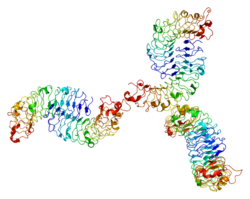Biglycan is a small leucine-rich repeat proteoglycan (SLRP) which is found in a variety of extracellular matrix tissues, including bone, cartilage and tendon. In humans, biglycan is encoded by the BGN gene[5] which is located on the X chromosome.
The name "biglycan" was proposed in an article by Fisher, Termine and Young in an article in the Journal of Biological Chemistry in 1989 because the proteoglycan contained two GAG chains; formerly it was known as proteoglycan-I (PG-I).[6]
- ^ a b c GRCh38: Ensembl release 89: ENSG00000182492 – Ensembl, May 2017
- ^ a b c GRCm38: Ensembl release 89: ENSMUSG00000031375 – Ensembl, May 2017
- ^ "Human PubMed Reference:". National Center for Biotechnology Information, U.S. National Library of Medicine.
- ^ "Mouse PubMed Reference:". National Center for Biotechnology Information, U.S. National Library of Medicine.
- ^ Traupe H, van den Ouweland AM, van Oost BA, Vogel W, Vetter U, Warren ST, Rocchi M, Darlison MG, Ropers HH (June 1992). "Fine mapping of the human biglycan (BGN) gene within the Xq28 region employing a hybrid cell panel". Genomics. 13 (2): 481–3. doi:10.1016/0888-7543(92)90279-2. PMID 1612609.
- ^ Fisher LW, Termine JD, Young MF (March 1989). "Deduced protein sequence of bone small proteoglycan I (biglycan) shows homology with proteoglycan II (decorin) and several nonconnective tissue proteins in a variety of species". J. Biol. Chem. 264 (8): 4571–6. doi:10.1016/S0021-9258(18)83781-4. PMID 2647739.







